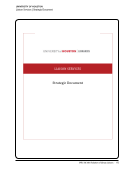26 · Survey Results: Survey Questions and Responses
However, we had subject librarians and even bibliographers going far back before 2004.
In 2004, the program began, but was in the developmental stages. Around 2007, the program became a more
formalized, structured program.
The job title “liaison librarian” started being used in 2007. Prior to that, librarians were subject specialists.
The library had a traditional bibliographer/reference department model in place until 2007, when a new liaison
program was created. Prior to 2007, bibliographers and special collections-related staff served as liaisons to academic
departments. Instruction was the purview of the reference department.
There had previously been a number of people who served in a liaison capacity, but the more “formal” removal of
bibliographers happened around this time (early 2000s).
This is a little fuzzy (2006). It has been a gradual move.
This (2000) is our best estimate as to when the title “liaison” was put into use at our library. There was an evolution
from “selectors” with strictly internal collection development responsibilities to “liaisons” with outreach responsibilities
over a period of several years.
This was following several years of pilots. Some subject-specific libraries offered liaison-style services to their disciplinary
communities long before 2007. 2007 represents the date that system-wide liaison was implemented.
2010s
While many of the elements of liaison services were in place for decades, we began a review of professional librarian
roles in 2010, and adopted a staff-generated proposal for restructuring using the liaison paradigm in 2012–2013.
4. How were the liaison roles determined? Check all that apply. N=67
Library administrative decision 56 84%
Library’s perceived needs of a department(s) in the institution 48 73%
Informal conversations with members of the department(s) 26 39%
Formal meetings with department groups 18 27%
Surveyed members of the department(s) 8 12%
Other process 21 32%
Please briefly describe the other process. N=21
Again, this is a guess since I wasn’t working here then.
Based on suggestions from a consulting agency, Booz, Allen, Hamilton, Inc.
Examining other liaison models and best practices.
Formal strategic planning, review of the literature, surveys to liaison librarians at other institutions.
Grew out of existing subject librarian roles and functions.
In some strategic areas, additional funding has been identified to hire a liaison librarian to meet specific needs
(Executive MBA program and Sustainable Energy, Environment, and Economy).
However, we had subject librarians and even bibliographers going far back before 2004.
In 2004, the program began, but was in the developmental stages. Around 2007, the program became a more
formalized, structured program.
The job title “liaison librarian” started being used in 2007. Prior to that, librarians were subject specialists.
The library had a traditional bibliographer/reference department model in place until 2007, when a new liaison
program was created. Prior to 2007, bibliographers and special collections-related staff served as liaisons to academic
departments. Instruction was the purview of the reference department.
There had previously been a number of people who served in a liaison capacity, but the more “formal” removal of
bibliographers happened around this time (early 2000s).
This is a little fuzzy (2006). It has been a gradual move.
This (2000) is our best estimate as to when the title “liaison” was put into use at our library. There was an evolution
from “selectors” with strictly internal collection development responsibilities to “liaisons” with outreach responsibilities
over a period of several years.
This was following several years of pilots. Some subject-specific libraries offered liaison-style services to their disciplinary
communities long before 2007. 2007 represents the date that system-wide liaison was implemented.
2010s
While many of the elements of liaison services were in place for decades, we began a review of professional librarian
roles in 2010, and adopted a staff-generated proposal for restructuring using the liaison paradigm in 2012–2013.
4. How were the liaison roles determined? Check all that apply. N=67
Library administrative decision 56 84%
Library’s perceived needs of a department(s) in the institution 48 73%
Informal conversations with members of the department(s) 26 39%
Formal meetings with department groups 18 27%
Surveyed members of the department(s) 8 12%
Other process 21 32%
Please briefly describe the other process. N=21
Again, this is a guess since I wasn’t working here then.
Based on suggestions from a consulting agency, Booz, Allen, Hamilton, Inc.
Examining other liaison models and best practices.
Formal strategic planning, review of the literature, surveys to liaison librarians at other institutions.
Grew out of existing subject librarian roles and functions.
In some strategic areas, additional funding has been identified to hire a liaison librarian to meet specific needs
(Executive MBA program and Sustainable Energy, Environment, and Economy).












































































































































































































